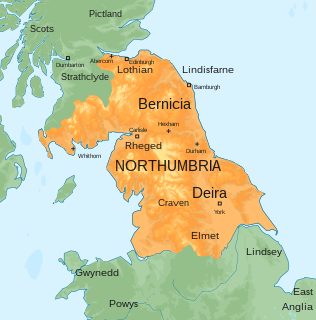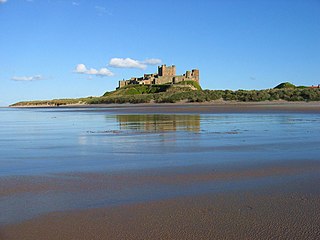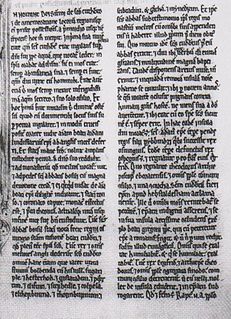Related Research Articles

The Kingdom of Northumbria was an early medieval Anglo-Saxon kingdom in what is now Northern England and south-east Scotland.

Cuthbert was an Anglo-Saxon saint of the early Northumbrian church in the Celtic tradition. He was a monk, bishop and hermit, associated with the monasteries of Melrose and Lindisfarne in what might loosely be termed the Kingdom of Northumbria, in North East England and the South East of Scotland. After his death he became the most important medieval saint of Northern England, with a cult centred on his tomb at Durham Cathedral. Cuthbert is regarded as the patron saint of Northumbria. His feast days are 20 March, also 31 August and 4 September.
Symeonof Durham was an English chronicler and a monk of Durham Priory.

Siward or Sigurd was an important earl of 11th-century northern England. The Old Norse nickname Digri and its Latin translation Grossus are given to him by near-contemporary texts. Siward was probably of Scandinavian origin, perhaps a relative of Earl Ulf, and emerged as a powerful regional strongman in England during the reign of Cnut. Cnut was a Scandinavian ruler who conquered England in the 1010s, and Siward was one of the many Scandinavians who came to England in the aftermath of that conquest. Siward subsequently rose to become sub-ruler of most of northern England. From 1033 at the latest Siward was in control of southern Northumbria, that is, present-day Yorkshire, governing as earl on Cnut's behalf.
Eadwulf or Eadulf was a ruler in Northumbria in the early tenth century. According to genealogy of Waltheof, Earl of Northampton, Eadwulf was the son of Æthelthryth daughter of Ælla, King of Northumbria--though this genealogy is not a contemporary one.
Ealdred was the son of Eadwulf. He was a ruler of at least part of the former kingdom of Bernicia in northern Northumbria in the early tenth century.

Osulf was high-reeve of Bamburgh and ruler of Northumbria. Sometimes called "earl", he is more surely the first recorded high-reeve of Bamburgh and the man who, after assisting in the death of its last independent ruler Erik Bloodaxe, administered the York-based Kingdom of Northumbria when it was taken over by the Wessex-based King Eadred of England in 954.
Eardulf of Lindisfarne was Bishop of Lindisfarne for 46 years between 854, following the death of his predecessor, and his own death in 899. He was chiefly responsible for removing the remains of St Cuthbert from Lindisfarne to protect them from Viking invasions, eventually resettling them in Chester-le-Street and temporarily running the see from there.

St Cuthbert's Cave, known locally as Cuddy's Cave or Cove, can refer to one of two natural sandstone caves in Northumberland that have been traditionally associated with Saint Cuthbert, the seventh century Anglo-Saxon monk, bishop and hermit.

The Libellus de exordio atque procursu istius, hoc est Dunhelmensis, ecclesie, in short Libellus de exordio, is a historical work of marked literary character composed and compiled in the early 12th-century and traditionally attributed to Symeon of Durham. It relates the history of bishopric and church of Durham and its predecessors at Lindisfarne and Chester-le-Street (Cunecacestre). It is sometimes also known as the Historia Dunelmensis ecclesiae.

De primo Saxonum adventu is a historical work, probably written in Durham during the episcopate of Ranulf Flambard (1099–1128). It recounts the coming of the English to Great Britain, treating individually the history of the rulers of the Kingdom of Kent, the Kingdom of East Anglia, the Kingdom of Northumbria, as well as the archbishops of Canterbury and the archbishops of York, the bishops of Durham and the earls of Northumbria.
Eadulf Rus was an 11th-century Northumbrian noble, and the first recorded 'of Swinton'. He was either the son or grandson of Gospatric, possibly the man who soon after Christmas 1064 was allegedly killed on behalf of Tostig, Earl of Northumbria. This murder by Tostig led to a great northern revolt against Edward the Confessor, a revolt that turned both King Edward and Harold Godwinson against Tostig and led to the appointment of the Mercian, Morcar, as Earl of northern England.
Northman was a late 10th-century English ealdorman, with a territorial base in Northumbria north of the River Tees. He appears in two different strands of source. These are, namely, the textual tradition of Durham witnessed by Historia de Sancto Cuthberto and the Durham Liber Vitae, and an appearance in a witness list of a charter of King Æthelred II dated to 994. The latter is Northman's only appearance south of the Humber, and came the year after Northumbria was attacked by Vikings.

Tidfrith or Tidferth was an early 9th-century Northumbrian prelate. Said to have died on his way to Rome, he is the last known Anglo-Saxon bishop of Hexham. This bishopric, like the bishopric of Whithorn, probably ceased to exist, and was probably taken over by the authority of the bishopric of Lindisfarne. A runic inscription on a standing cross found in the cemetery of the church of Monkwearmouth is thought to bear his name.
Thurbrand, nicknamed "the Hold", was a Northumbrian magnate in the early 11th-century. Perhaps based in Holderness and East Yorkshire, Thurbrand was recorded as the killer of Uhtred the Bold, Earl of Northumbria. The killing appears to have been part of the war between Sweyn Forkbeard and Cnut the Great against the English king Æthelred the Unready, Uhtred being the latter's chief Northumbrian supporter. Thurbrand may also have attested a charter of 1009 and given a horse to Æthelred's son Æthelstan Ætheling. The killing is the first known act, if it did not initiate, a bloodfeud between Thurbrand's family and Uhtred going into the time of Earl Waltheof. It is possible that Holderness took its name because of Thurbrand's presence or ownership of the peninsula.
Billfrith is an obscure Northumbrian saint credited with providing the jewel and metalwork encrusting the former treasure binding of the Lindisfarne Gospels. His name is thought to mean "peace of the two-edge sword".
Onlafbald and Scula were two early 10th century Viking chieftains, notable for receiving lands through successful campaigning in what is now northern England. Onlafbald is also said to have been killed by the spirit of the 7th-century English saint Cuthbert of Lindisfarne, after he profaned the long-dead saint. The legacy of Scula is preserved in the place name of School Aycliffe, a village in County Durham, which is derived from his name.

The Historia de Sancto Cuthberto is a historical compilation finished some time after 1031. It is an account of the history of the bishopric of St Cuthbert—based successively at Lindisfarne, Norham, Chester-le-Street and finally Durham—from the life of St Cuthbert himself onwards. The latest event documented is a grant by King Cnut, c. 1031. The work is a cartulary chronicle recording grants and losses of property as well as miracles of retribution, under a loose narrative of temporal progression. The text survives in three manuscripts, the earliest of which dates from around 1100. The original version of the text is not thought to be extant; rather, all surviving manuscripts are thought to be copies of an earlier but lost exemplar. The Historia is one of the important sources behind the higher quality expanded histories produced at Durham in the early 12th century, particularly the Historia Regum and Symeon of Durham's Libellus de Exordio.
Cambridge University Library, Ff. i.27 is a composite manuscript at the University of Cambridge. It was formed by adding a 14th-century Bury St Edmunds book to a compendium of material from 12th-century northern England. The latter compendium had once been part of Corpus Christi College Cambridge MS 66. With its original content, it had at one time been at Sawley Abbey, though it was probably produced somewhere else, perhaps Durham. It is a source for the Durham poem, which describes the city and its relics.

Cuncacestre (Chester-le-Street) was a seat of the Anglo Saxon Bishop of Lindisfarne, and subsists as a Roman Catholic titular see.
References
- Rollason, David, ed. (2000), Libellus de exordio atque procursu istius, hoc est Dunhelmensis, ecclesie = Tract on the origins and progress of this the Church of Durham / Symeon of Durham, Oxford Medieval Texts, Oxford: Clarendon Press, ISBN 0-19-820207-5
- Rollason, David (2003), Northumbria, 500–1100: Creation and Destruction of a Kingdom, Cambridge: Cambridge University Press, ISBN 0-521-04102-3
- South, Ted Johnson, ed. (2002), Historia de Sancto Cuthberto: A History of Saint Cuthbert and a Record of His Patrimony, Anglo-Saxon Texts No 3, Cambridge: D. S. Brewer, ISBN 0-85991-627-8
- Woolf, Alex (2007), From Pictland to Alba, 789–1070, The New Edinburgh History of Scotland, Edinburgh: Edinburgh University Press, ISBN 978-0-7486-1234-5